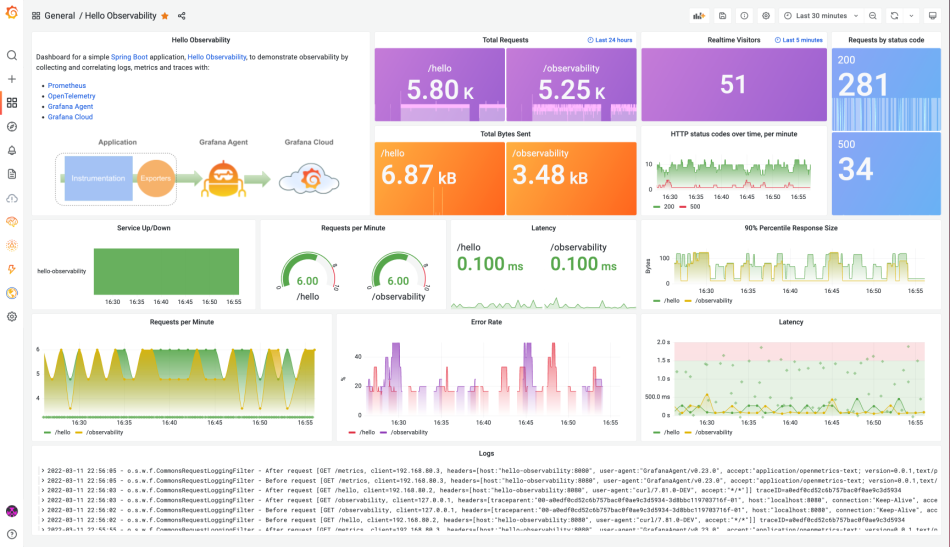Build a Custom Event Logger for API Monitoring in Spring Boot
 Tuanhdotnet
Tuanhdotnet4 min read

1. Why Do You Need a Custom Event Logger?
A custom event logger enables you to track API interactions precisely by logging essential details like request payloads, response data, and execution times. Unlike generic logging libraries, a custom solution lets you:
- Tailor the logging structure to your application.
- Log specific business-critical events.
- Facilitate real-time debugging and monitoring.
2. Building an Event Logger in Spring Boot
To create a reliable event logger, we’ll leverage Aspect-Oriented Programming (AOP) for intercepting API calls and a structured logging approach for storing the logs.
2.1 Setting Up Dependencies
First, include the necessary dependencies in your pom.xml file to support AOP and database logging:
<dependency>
<groupId>org.springframework.boot</groupId>
<artifactId>spring-boot-starter-aop</artifactId>
</dependency>
<dependency>
<groupId>org.springframework.boot</groupId>
<artifactId>spring-boot-starter-data-jpa</artifactId>
</dependency>
<dependency>
<groupId>com.h2database</groupId>
<artifactId>h2</artifactId>
<scope>runtime</scope>
</dependency>
2.2 Designing the Log Entity
Create a database entity to store log information. This ensures all events are persistable and can be queried later for analysis.
@Entity
public class LogEvent {
@Id
@GeneratedValue(strategy = GenerationType.IDENTITY)
private Long id;
private String apiName;
private String httpMethod;
private String requestPayload;
private String responsePayload;
private long executionTime;
private LocalDateTime timestamp;
// Getters and Setters
}
2.3 Building the Repository
Define a repository interface to handle data storage for log events:
@Repository
public interface LogEventRepository extends JpaRepository<LogEvent, Long> {
}
2.4 Implementing the Logging Aspect
The heart of the solution lies in using AOP to intercept and log API interactions. We’ll create an aspect that captures request and response details along with execution time.
@Aspect
@Component
public class LoggingAspect {
private final LogEventRepository logEventRepository;
public LoggingAspect(LogEventRepository logEventRepository) {
this.logEventRepository = logEventRepository;
}
@Around("@annotation(org.springframework.web.bind.annotation.RequestMapping) || @annotation(org.springframework.web.bind.annotation.GetMapping)")
public Object logApiCalls(ProceedingJoinPoint joinPoint) throws Throwable {
long startTime = System.currentTimeMillis();
// Capture API details
MethodSignature signature = (MethodSignature) joinPoint.getSignature();
String apiName = signature.getDeclaringTypeName() + "." + signature.getName();
String httpMethod = signature.getMethod().getAnnotations()[0].annotationType().getSimpleName();
Object requestPayload = joinPoint.getArgs();
// Proceed with the API execution
Object response = joinPoint.proceed();
long executionTime = System.currentTimeMillis() - startTime;
// Capture response details and save the log
LogEvent logEvent = new LogEvent();
logEvent.setApiName(apiName);
logEvent.setHttpMethod(httpMethod);
logEvent.setRequestPayload(Arrays.toString(requestPayload));
logEvent.setResponsePayload(response.toString());
logEvent.setExecutionTime(executionTime);
logEvent.setTimestamp(LocalDateTime.now());
logEventRepository.save(logEvent);
return response;
}
}
2.5 Testing the Logger
Add sample API endpoints to validate the logger. For example:
@RestController
@RequestMapping("/api")
public class SampleController {
@GetMapping("/test")
public ResponseEntity<String> testEndpoint() {
return ResponseEntity.ok("Hello, World!");
}
@PostMapping("/data")
public ResponseEntity<String> postData(@RequestBody Map<String, String> data) {
return ResponseEntity.ok("Data received: " + data);
}
}
When these endpoints are invoked, the logger will automatically capture and persist details about the API calls.
3. Key Insights From the Logger
The logger captures several critical details:
- API Name and HTTP Method: To identify which endpoint was called.
- Request and Response Payloads: To debug input and output data.
- Execution Time: To identify slow-performing APIs.
- Timestamp: To trace when the event occurred.
Analyzing API Performance
With the execution time data, you can monitor and optimize slow APIs to enhance overall performance.
Troubleshooting Faster
Logs provide immediate insights into what went wrong during API interactions, minimizing the time spent debugging issues.
Building Real-Time Dashboards
Integrate the logs with external tools like Elasticsearch and Kibana to create real-time monitoring dashboards.
The basic logger works well, but there’s room for improvement:
- Dynamic Log Levels: Use Spring Boot Actuator to control the verbosity of logs dynamically.
- Excluding Sensitive Data: Mask or skip logging sensitive fields to ensure data privacy.
- Asynchronous Logging: Use tools like Logback to make the logging process non-blocking and improve API performance.
5. Conclusion
Building a custom event logger in Spring Boot not only enhances API monitoring but also improves debugging, performance analysis, and compliance. By leveraging AOP and Spring Boot’s repository capabilities, you can create a powerful, extensible logging service tailored to your application’s needs.
Have questions or want to share your thoughts? Drop a comment below! Let’s dive deeper into your logging challenges together.
Read more at : Build a Custom Event Logger for API Monitoring in Spring Boot
0
Subscribe to my newsletter
Read articles from Tuanhdotnet directly inside your inbox. Subscribe to the newsletter, and don't miss out.
Written by

Tuanhdotnet
Tuanhdotnet
I am Tuanh.net. As of 2024, I have accumulated 8 years of experience in backend programming. I am delighted to connect and share my knowledge with everyone.